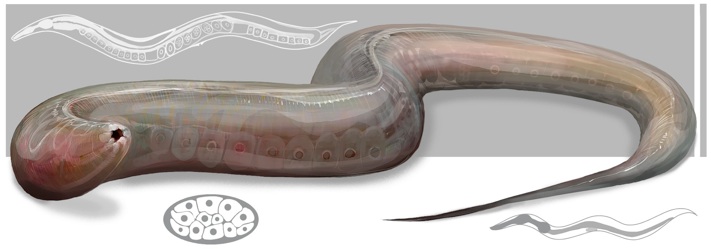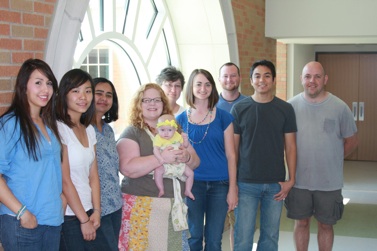SUSPENDED ANIMATION, ANOXIA SURVIVAL, AND DIAPAUSE
The focus of the Padilla lab is to understand how organisms respond to and survive environmental stress. We are particularly interested in identifying the molecular mechanisms involved with hypometabolic states. Specifically, we study anoxia-induced suspended animation in Caenorhabditis elegans and the obligate diapause II state observed in the killifish embryo (Austrofundulus limnaeus). Our lab takes a genetic and cellular approach for studying these phenomena.
Anoxia-Induced Suspended Animation in C. elegans
C. elegans, a soil nematode, originally isolated in Bristol, England has evolved mechanisms to survive changes in oxygen levels. In fact C. elegans can survive severe oxygen deprivation (hypoxia and anoxia) yet these stresses will impact behavior, growth and development. The C. elegans animal exposed to anoxia will enter into a reversible state of suspended animation in which observable biological processes, such as cell division, development, eating, egg laying, fertilization and movement arrests until air is reintroduced into the environment. Anoxia-induced suspended animation can be maintained for a few days, depending on the developmental stage of exposure; extended anoxia exposures lead to tissue damage and eventually lethality. We are investigating the cellular changes associated with oxygen deprivation at various stages of development as well as in the aging adult animal. Furthermore, we use genetic approaches to identify molecular mechanisms that increase anoxia survival. Understanding oxygen deprivation in a genetic model system such as C. elegans is of interest and can be used to understand many human health related issues (cardiac and pulmonary dysfunction, trauma, diabetes, solid tumor progression etc).
Killifish Embryonic Diapause
In a natural environment many organisms enter into a metabolic arrest in response to either an environmental cue or a significant stress. Fascinating examples of metabolic and/or developmental arrests include diapause, torpor and hibernation. Austrofundulus limnaeus is a freshwater annual killifish from Venezuela that produces embryos capable of entering three distinct stages of diapause. Diapause II, which is a state of developmental arrest that can last over 100 days and confers extreme anoxia tolerance, provides a great opportunity to study developmental arrest in a vertebrate animal without exposing the organism to compounding stresses. Currently, little is known about the molecular mechanisms that induce and maintain this developmentally arrested state. We are using the killifish embryo as a model to better understand arrest of developmental processes. We are developing new techniques including cell biology in this model to better understand this fascinating aspect of biology. The killifish we study were originally obtained from our colleague and collaborator (Jason Podrabsky, Professor Portland State University).
Science Education
Central to the goal of the lab is not only research but the educational process of students to become scientists. Dr. Padilla was awarded an NSF CAREER grant to not only further the research on anoxia-induced suspended animation in C. elegans but to also develop discovery-based lessons for Genetics undergraduate students. Through the work of many, it is known that gene function is often elucidated by phenotype analysis of genetic mutants. Biology undergraduate students learn in lectures about gene function and analysis conducted in model systems to understand genes that regulate specific biological processes. However, most students have not experienced how one could discover genes involved with a specific biological process. Providing discovery-based lessons is particularly a challenge at large state universities, such as UNT, where the undergraduate student population is large and laboratory projects are “cookbook” in nature. The goal of the newly-developed Genetics laboratory module is to expose students to the steps of understanding a biological process via isolation and characterization of a genetic mutant. A key component of this is that students isolate a mutant with a phenotype of interest to them. This module provides an opportunity for students to learn how biological processes can be mechanistically understood using a genetic model system. The model system used for this lesson is Caenorhabditis elegans. Many undergraduate science students, especially from large state universities like UNT, do not have the opportunity to conduct research in a laboratory setting and thus miss out on understanding a foundational aspect of science (research and discovery). A challenge that is facing our nation is to better teach students important aspects of science. Further, exposing undergraduate students in the classroom to what is central to science (discovery) is of great interest for not only this lab but for the future and interests of our academic institutes.
Significance of Research and Educational Focus
Cellular death induced by a lack of homeostasis and metabolic imbalance is associated with many human health related issues. For example, oxygen deprivation is central to many human health related issues including pulmonary dysfunction, myocardial infarction, blood loss, stroke, and solid tumor resistance to therapies. Thus, the genetic, physiological and cellular approaches we use to better understand oxygen deprivation, suspended animation and arrest such as diapause II can contribute to a greater understanding of many disease processes.
The PI is very interested in the educational training of our nations future scientists as well as the educational process Biology students are exposed to. Padilla lab members range from the High school level (TAMS program) to the PhD level. Published manuscripts from our lab have included students from various stages of their education (high school, undergraduate and graduate MS or PhD level).



